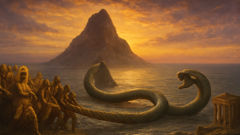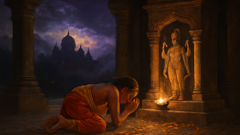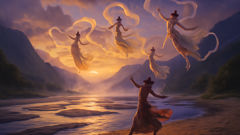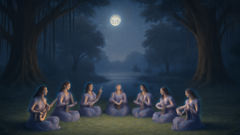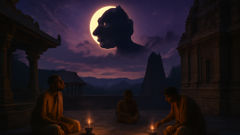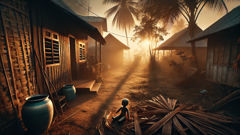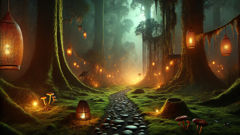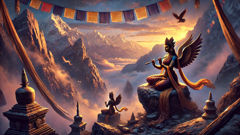Introduction
When the world was young and the sky still listened with a stillness no human tongue can name, the gods—bright and fragile in the daytime—found themselves diminished. They had lost their edge to cunning forces that lived on cunning: the Asuras, mighty and ambitious, who turned power toward domination. The Devas, keepers of order and light, were pushed back from their abodes among the luminous halls. It was a crisis without trumpets, the kind that hums in the marrow of things. So they gathered, not with banners but with counsel, and spoke of a single extraordinary hope: the amrita, the nectar that makes death a trembling thing beneath a stronger will. But amrita was not a thing found by accident; it had to be coaxed from the belly of the ocean itself, from the milky depths churned by cosmic forces. The plan, audacious as any old story that changed destinies, required a rod to pierce the sea, a rope to draw it, and allies—strange allies, for only by a combined effort of Devas and Asuras could the ocean be turned. Thus began a tale of collaboration and conflict, of poison and cure, of things more than jewels rising from a stirring sea: the truths we drown in and the truths we drink. What follows is a retelling of that churning, not as a litany of cataloged marvels but as a living scene—sound, smell, and salt on the skin—where ambition and humility meet to shape a fragile peace.
The Alliance: Rod, Serpent, and Resolve
The council was a hush-heavy thing, held on a bright cliff above an ocean whose color no painter could trust to a single name. The Devas gathered—some rugged, some luminous, each with the patience of those who manage a world’s light—and at their center stood Indra, keeper of thunder and the brittle crown of leadership. Beside him moved those older than war: Brahma, who measured time in thought; Vishnu, whose calm shadow watched all; and others whose names came wrapped in ritual. When the plan for the churning was set, it read like a map of desperate ingenuity. A mountain would be a rod; Mount Mandara, taken from the deep places, would act as the fulcrum. A serpent would be the cord; Vasuki, great and sinuous, would be coiled, and both devas and asuras would take hold of him to wind the sea.
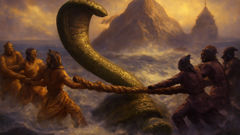
No single image tells the first emotion of the enterprise: wonder braided with fear. The Asuras, who had the appetite of those who believe themselves deprived, were not simply foes but necessary pieces in a machine that could not be made otherwise. Their arms were strong and their hunger vast, and that hunger made them willing. For the Devas it was humiliation and hope braided together—they had to partner with the very shadow that had bested them. They remembered ancient oaths and the fragile balance of the cosmos; yet memory did not supply the muscle. So they appealed to the earth and to the devout: Brahma’s counsel persuaded the mountain to float, and Vishnu in thought found a shape of support. Mount Mandara rose like a sleeping island, massive and awkward, its sides slick with sea-spray and its crown wreathed in cloud. It shuddered and sighed as it floated, as if a giant beneath the skin of the ocean had been brushed awake.
Vasuki, when offered the role of rope, flicked his tongue and smelled both caution and opportunity. Serpents know motion and the scent of currents, and Vasuki’s mind was older than many seasons. He coiled his length, a living cord between the forces that sought control. When he offered himself, his scales shone like polished thought. Yet even as the plan moved, there were doubts—and not only among those who had been wronged. The mountain might sink the craft if the pivot were unstable; the serpent, if upset, could release venom too vast for even gods to swallow. So the Devas sought aid. Vishnu took the form of a great tortoise, Kurma, and beneath the churning rod he braced himself, offering a living platform to steady the mountain’s uneasy heart. There was humility in that act—a god willing to be a simple support, a plank in a lever that would tilt the fate of many.
When the teams took position, the air itself seemed to tighten. On one side, Devas—winged, radiant, their eyes like struck flint—gripped Vasuki’s head. On the other, Asuras—broad-shouldered, burning with ambition—fanned out along his tail. The plan asked that they pull in turn, that one side draw and then the other, creating a slow, patient roll that would stir the ocean’s depths. The first pull was like the first breath of a long sickness. The wave rose, not as a single gesture but as a series of careful responses; currents awakened, and the sky watched, breathless. As they pulled and released, the ocean yielded its hidden cargo. At first it was small things—pearls and shells, the kinds of gifts the sea gives when it is reminded of being attended. Then larger wonders as the churning went deeper: plants that whispered the language of algae, creatures that had never seen the sky. Every rise and fall offered a new wonder, and each wonder changed the mood of the labor. Hope warmed into greed, and greed into rivalry, for treasures have a way of teaching the heart to forget the bargain that created them.
Within that labor also came danger. As the sea was stirred, no single thing remained contained. Vapors rose thick and dark; from the deep came a poison so fierce that even the gods recoiled. A pale fog rolled across the faces of those who worked, and the world stilled to watch. Halahala, the great poison, rose like a black mouth and threatened to swallow the shore and all who bent over it. Indra and the other gods found their courage thinning; Asuras, for all their appetite, recoiled a moment as if the very center of their hunger had been threatened. The one who stepped forward to take the poison’s weight was Shiva. He gathered the fumes in his throat; the gods and demons watched as he tilted his head and held them there. His throat turned blue as the poison burned, and he bore it like a secret. The color stayed—that deep, impossible azure—and with that sacrifice the immediate peril receded. The churning could continue, but the tone had been set: efforts of great consequence always incur a cost, and even gods are required to shoulder what they cannot ignore.
So the work resumed. The mountain pivoted, the serpent slid, and the sea sighed open to more offerings. Each item pulled from the depths told its own story—a celestial horse, a luminous garland, a divine physician in the form of a wise man named Dhanvantari holding a pot that hummed with possibility. They were not mere baubles but signs: the universe, when disturbed, reveals not only riches but also responsibilities. The Devas received some treasures, the Asuras others, and every hand that took something did so with a quickening heartbeat. Among those gifts was the promise of amrita—the nectar the world had whispered of all along. Yet the nectar did not come as a calm cup. It came as demand and as test, requiring cunning, restraint, and a truth the sea had always known: that immortality, even as a concept, reshapes who drinks it and how the world will balance afterward.
The Gifts, Deceptions, and the Nectar’s Price
The ocean, once coaxed beyond routine, can be generous and cruel in equal measure. As the churning continued, it produced wonders that pushed the boundary between delight and dread. Celestial beings and objects rose wrapped in foam and light, each demanding attention the way a child demands a name. First came Lakshmi, whose emergence was soft as a prayer. She stepped onto the shore with a calm that settled the air, drawing the eyes of gods and demons alike. Her presence restored some dignity to the Devas. For a while the labor’s mood warmed: where greed had bloomed, gratitude now attempted to root. Yet the sequence of treasures carried its own logic—each gift distracted, each jewel tempted, and every distraction changed the axis of the work. The Asuras, seeing power in the gifts, hardened their hands. The Devas, buoyed by hope, grew more urgent.
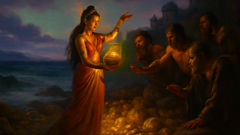
Then Dhanvantari rose, carrying the pot every heart had sketched in solitude. It glowed not like a jewel but like a question. When the physician emerged, the ocean seemed to hush, as if it had reached the most intimate part of its memory. The pot contained amrita, and its existence answered the reason for vanquishing comfort, calling for clarity. But amrita was a test more than a prize; it required distribution and will, a decision about who received the immortality that could so easily unmake the world’s balance. The Devas, having regained hope, grew anxious about securing the nectar. The Asuras, who had labored mightily and felt entitled to their reward, tightened their grip and readied to seize the cup. The scene collected a kind of inevitability: when scarcity is imagined, cooperation frays.
Vishnu moved then, quick with guile that wore a gentler face than force. He took on a form both disarming and deceptive—a woman of such luminous charm that the Asuras, who prided themselves on their strength, betrayed their own judgment. Mohini was the name given to that form; she was beautiful as a sunrise and cunning as an undertow. With soft words and deliberate grace she captured the eye of the Asuras and diverted their suspicion. She promised equitable sharing, and with practiced gentleness she handled the pot. One by one, she offered cups that would preserve life and hope. Yet every myth remembers that the Asuras were not merely players in a deception but reflectors of greed. Some drank unwisely; others were turned by vanity. The nectar passed into the hands of the Devas, granting them renewed vigor and reclaiming their place among the shining ones. The Asuras, humiliated by the loss, rushed to reclaim what they thought owed to them, and the world stuttered on the edge of a new war.
But the narrative does not end with trickery triumphant. The churning’s consequences spread beyond the immediate actors. The treasure-laden waves taught those who watched how desire shapes destiny. A horse braided of lightning taught kings to ride with a swiftness that could flatten compassion; a jeweled tree taught some to anchor their hope in objects rather than in steady bonds. For every boon the ocean gave, it issued a paradox: a thing that cured one ill might birth another. Even the amrita was not a cure-all for moral failure. Immortality without wisdom can make the heart more brittle, not less. Those who received the nectar did not automatically become wise; they became long-lived witnesses to the ramifications of their choices, and that longevity demanded a steadier mind.
In the aftermath, Vishnu’s role and Mohini’s deception became subjects of debate among sages and storytellers. Some praised cunning as necessary to restore cosmic balance; others argued that deception, even for a good end, plants seeds that bloom into future strife. The myth refuses to supply a tidy verdict. Instead it leaves a set of images: a god small enough to become tortoise to support others, a god vast enough to assume an enchanting guise, a serpent who allowed himself to be a rope, and a mountain that floated like a thought on the sea. Each image carries its own lesson. Cooperation between former enemies can achieve wonders, but the thing created—whether nectar or law—must be stewarded with humility. Those who took the amrita felt its warmth and learned that immortality did not mean the end of struggle; it merely changed the terms. The Devas, emboldened, regained their sky-palaces, but with them went a reminder—set as surely in story as in memory—that power gained by cunning invites vigilance.
The sea, for its part, returned to a quieter rhythm. It had been stirred, and its secrets were spent; shells and stars drifted, the surface smoothed, and the memory of boiling foam faded into the slow work of tides. Yet sometimes on certain nights, when the moon leans like a listening ear, fishermen and pilgrims will swear they feel a residual whisper under the water: a hum of an old working, of deals struck and prices paid. In that whisper there is a further lesson the myth keeps for posterity: that creation is messy, and that even the most radiant gifts carry shadows. The churning did not erase the world’s need for care; it intensified it. Beauty and poison rise on the same breath; gifts demand guardians. Those who tell the story of Samudra Manthan do not intend to teach simple formulas but to offer an image for a complex truth: that the work of shaping a world—whether through politics, ritual, or common labor—binds together wonder and caution, and that any craft of power must be accompanied by the willingness to pay its price.
Conclusion
The myth of the churning of the ocean of milk survives because it carries the intensity of things that never go away: collaboration that contains rivalry, sacrifice that leaves scars, and gifts that demand stewardship. In the story the world learns to make difficult bargains—the mountain becomes a tool, the serpent a rope, a god becomes a tortoise, another becomes a beguiling savior—and each act is both creative and costly. For audiences across ages, Samudra Manthan offers a mirror: it asks who we will be when faced with the chance to churn our own depths. Will we trade cunning for community, or will the nectar of life be swallowed alone? The tale does not give a single instruction so much as a set of images to live beside. Whether you read it as cosmology, an allegory of inner transformation, or a cautionary political hymn, it insists on responsibility. The ocean returned to its patient work, but the world that had watched learned to be wary of sudden gifts and grateful for steady hands. If the myth is a map, it is one that points not to a single treasure but to the practice of tending: tending power, tending life, tending the fragile net of relationships that keep a world from tipping. In that tending lies the quiet hope the Devas first pulled toward shore—a hope that even in the grind of desire and deception, there remains a way to take what the sea offers and answer its price with care.

